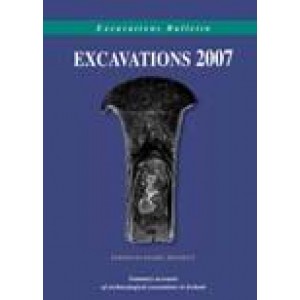As of November 2008, the Celtic Tiger has long left us and there has been a huge downturn in the economy, particularly in the construction industry, which of course has a knock-on effect on archaeological excavation work. This is only slightly reflected in this year’s (2007) bulletin, where there is a slight fall in the number of sites reported on, with 2066 summaries in the book. Quite a significant number of these are for sites dug during 2006, the real bumper year, so in reality the number is somewhat smaller. However, for a number of years now there are always a few catch-up summaries from the previous year reported on in each bulletin, so perhaps these sites are not skewing the figures too much. One must also consider the 200 or so sites for which summaries were not received, but then, this figure is also similar to that of last year, so not much change there either.
Once again this year there is an interesting range of sites. Some of those that stand out include No. 381, Ballycullen, Co. Down, where a Palaeolithic flint was found. There has been some debate about this find, with a leaning towards the possibility that it came from Scotland, but its discovery is still noteworthy. Still in early prehistory, Mesolithic and Neolithic fish traps were discovered at Spencer Dock, North Wall Quay, Dublin (No. 494). Another excavation that caught the eye was that of post-medieval kilns at Phoenixtown 4, Co. Meath (No. 1370), which may represent a poitín still. This must be the first excavation of such a site (if that is what is was!) We have had relatively recent post offices, forges and dwelling houses excavated in the past, and this year, in No. 1365 Philpotstown 3, also in Co. Meath, we have a school which dates from 1860–1940. So this bulletin has examples perhaps of the oldest and most recently dated findings from Irish archaeolgy.
Another novelty this year is the combination of TV and archaeology with the participation of the Time Team in the excavation of No. 1770, Castle Hill, Dungannon, Co. Tyrone. This is not the first time that the Time Team has excavated sites in Northern Ireland, but certainly is the first in quite a while.
Once again this year the distribution and density of excavations is governed by infrastructural development, particularly road schemes. Tipperary has the most sites excavated, at 186 sites (with a further 9 licences issued), followed by Meath with 170 sites (with 6 more licences issued) and Kilkenny, with 164 sites (and 13 further issued). Counties Cork, Dublin and Kildare are not far behind. At the other extreme, Leitrim has the smallest number of sites, 10 excavations, followed by Monaghan, with 11 sites (and one further licence issued) and Longford, with 12 sites. Cavan, Derry and Fermanagh also have very few excavations. Perhaps in 2008, with fewer infrastructural developments starting, there will be a more even distribution of sites around the country.
| Details | |
| Author | Edited by Isabel Bennett |
| Publication Data | Published 2010, hardback, 500pp, illustrated. |
| Subjects | General Interest |
Excavations 2007: summary accounts of archaeological excavations in Ireland
- ISBN: 978 1 90556942 7
- Author(s): Edited by Isabel Bennett
- Availability: In Stock
-
€40.00

